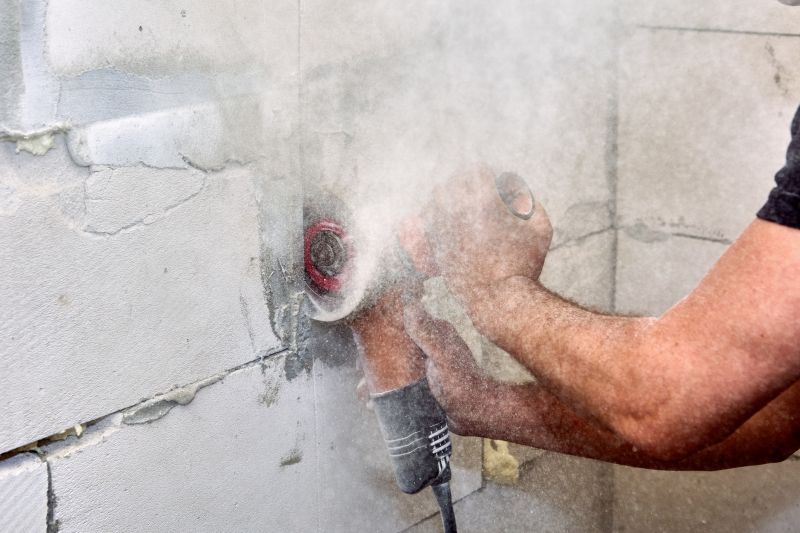Top-Rated Concrete Cutting Equipment For Accurate and Fast Results
Compare high-performance tools built to handle tough concrete with precision, reducing time and improving project quality.
 Products for concrete cutting encompass a wide range of tools and accessories designed to facilitate precise and efficient modifications of concrete surfaces. Whether for construction, renovation, or repair projects, selecting the right equipment is essential for achieving clean cuts and minimizing effort. Power tools such as angle grinders, circular saws, and demolition saws are commonly used, often equipped with specialized blades or diamond-tipped cutting discs tailored for concrete. Handheld options provide portability and control for smaller tasks, while larger, stationary equipment is suited for extensive cutting jobs. Safety gear including goggles, gloves, and dust masks is equally important to ensure safe operation during concrete cutting activities.
Products for concrete cutting encompass a wide range of tools and accessories designed to facilitate precise and efficient modifications of concrete surfaces. Whether for construction, renovation, or repair projects, selecting the right equipment is essential for achieving clean cuts and minimizing effort. Power tools such as angle grinders, circular saws, and demolition saws are commonly used, often equipped with specialized blades or diamond-tipped cutting discs tailored for concrete. Handheld options provide portability and control for smaller tasks, while larger, stationary equipment is suited for extensive cutting jobs. Safety gear including goggles, gloves, and dust masks is equally important to ensure safe operation during concrete cutting activities.
Top Overall Option
Diamond Blade for Concrete Cutting
A high-quality diamond blade is a versatile and durable choice for cutting through concrete surfaces. Designed to provide precise cuts with minimal effort, it is suitable for various power tools and project sizes. Its robust construction ensures longevity, making it a reliable component of any concrete cutting toolkit.
Types of Products For Concrete Cuttings
Angle Grinder with Diamond Blade
A handheld power tool ideal for small to medium cuts, equipped with a diamond blade for efficient concrete slicing.
Concrete Circular Saw
A dedicated saw designed for straight cuts in concrete slabs and walls, offering stability and precision.
Walk-Behind Concrete Saw
A larger, walk-behind machine suited for extensive cutting tasks on pavements and large slabs.
Handheld Demolition Saw
Portable saws used for demolition and rough cuts, often equipped with diamond blades for durability.
Core Drilling Machines
Specialized equipment for creating precise holes in concrete surfaces, often used for pipes and wiring.
Wet Cutting Systems
Tools that incorporate water cooling to reduce dust and heat during cutting, enhancing safety and blade life.
Cutting Discs for Angle Grinders
Circular blades designed for angle grinders, suitable for small cuts and detailed work in concrete.
Diamond Wire Saws
Heavy-duty saws that use diamond-coated wire for cutting through large concrete structures and slabs.
Reciprocating Saws with Concrete Blades
Versatile saws equipped with specialized blades for demolition and rough cuts in concrete.
Tile and Masonry Saws
Compact saws suitable for cutting tiles and smaller concrete pieces with precision.
Popular Choices
Widely used for its durability and efficiency in cutting through concrete surfaces.
A portable power tool favored for its ease of use and flexibility in various cutting tasks.
Popular for large-scale projects requiring straight, clean cuts in concrete slabs.
A go-to tool for demolition and rough cuts, appreciated for its mobility.
Preferred for dust control and blade longevity during extensive cutting operations.
Chosen for heavy-duty cutting of large concrete structures and precision demolition.
Versatile and handy for demolition and detailed cuts in concrete materials.
Essential for creating precise holes in concrete, used in plumbing and electrical installations.
Compact and efficient for cutting tiles, bricks, and smaller concrete pieces.
Popular for their versatility in small to medium cutting tasks with angle grinders.
The durability and performance of concrete cutting tools depend heavily on blade quality and material compatibility. Diamond blades are highly regarded for their ability to cut through tough concrete surfaces with relative ease, offering longevity and precision. For more delicate or detailed cuts, specialized blades with finer teeth or specific configurations can be utilized. Additionally, water-cooled cutting systems help reduce dust and heat generation, contributing to cleaner work environments and extended tool life. When choosing products, considerations such as the size of the cut, the type of concrete, and the available power source should influence your selection.
Proper maintenance and handling of concrete cutting tools are crucial for optimal performance and safety. Regular inspection for wear and tear, appropriate lubrication, and correct storage can prolong the lifespan of your equipment. It is also advisable to match the blade or tool type to the specific task at hand to ensure efficiency and safety. With a variety of options available, from versatile handheld tools to large industrial machines, users can find solutions tailored to both small-scale projects and large construction sites. Investing in quality products and understanding their features can significantly impact the success of your concrete cutting endeavors.
Key Buying Considerations
- Type of concrete material and its hardness to select appropriate blades or tools.
- Size and scope of the project to determine whether handheld or large machinery is needed.
- Power source availability, such as corded electric, cordless, or gas-powered equipment.
- Blade compatibility with your existing tools or machinery.
- Cutting precision requirements for detailed versus rough cuts.
- Dust and debris management features, including dust extraction or water cooling systems.
- Blade diameter and thickness for achieving desired cut depth and accuracy.
- Ease of handling and weight of the equipment for safety and comfort.
- Durability and lifespan of blades and tools based on material quality.
- Availability of replacement parts and accessories for ongoing maintenance.
- Safety features such as blade guards, emergency stops, and ergonomic design.
- Noise levels and vibration control for operator comfort.
- Budget constraints balanced with quality and performance needs.
- Manufacturer reputation and user reviews for reliability insights.
- Compliance with safety standards and certifications.
This page contains affiliate links. We may earn a commission if you purchase through these links, which helps support our content.
